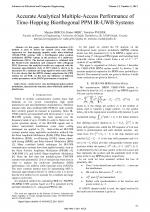| 2/2011 - 10 |
Accurate Analytical Multiple-Access Performance of Time-Hopping Biorthogonal PPM IR-UWB SystemsHERCEG, M. |
| Extra paper information in |
| Click to see author's profile in |
| Download PDF |
Author keywords
symbol error rate, biorthogonal pulse position modulation, characteristic function, ultra-wideband, multi-user interference
References keywords
modulation(7), systems(6), multiple(6), communications(6), time(5), hopping(5), access(5), ultra(4), pulse(4)
Blue keywords are present in both the references section and the paper title.
About this article
Date of Publication: 2011-05-30
Volume 11, Issue 2, Year 2011, On page(s): 63 - 66
ISSN: 1582-7445, e-ISSN: 1844-7600
Digital Object Identifier: 10.4316/AECE.2011.02010
Web of Science Accession Number: 000293840500010
SCOPUS ID: 79958819490
Abstract
In this paper, the characteristic function (CF) method is used to derive the symbol error rate (SER) expression for time-hopping impulse radio ultra-wideband (TH-IR-UWB) systems with a biorthogonal pulse position modulation (BPPM) scheme in the presence of a multi-user interference (MUI). The derived expression is validated with the Monte-Carlo simulation and compared with orthogonal PPM. Moreover, the analytical results are compared with the Gaussian approximation (GA) of MUI which is shown to be inaccurate for a medium and large signal-to-noise ratio (SNR). It is also shown that the BPPM scheme outperforms the PPM scheme for all SNR. At the end, the influence of different system parameters on the BPPM performance is analyzed. |
| References | | | Cited By |
Web of Science® Times Cited: 0
View record in Web of Science® [View]
View Related Records® [View]
Updated 2 weeks, 6 days ago
SCOPUS® Times Cited: 0
View record in SCOPUS® [Free preview]
There are no citing papers in the CrossRef Cited-by Linking system.
Disclaimer: All information displayed above was retrieved by using remote connections to respective databases. For the best user experience, we update all data by using background processes, and use caches in order to reduce the load on the servers we retrieve the information from. As we have no control on the availability of the database servers and sometimes the Internet connectivity may be affected, we do not guarantee the information is correct or complete. For the most accurate data, please always consult the database sites directly. Some external links require authentication or an institutional subscription.
Web of Science® is a registered trademark of Clarivate Analytics, Scopus® is a registered trademark of Elsevier B.V., other product names, company names, brand names, trademarks and logos are the property of their respective owners.
Faculty of Electrical Engineering and Computer Science
Stefan cel Mare University of Suceava, Romania
All rights reserved: Advances in Electrical and Computer Engineering is a registered trademark of the Stefan cel Mare University of Suceava. No part of this publication may be reproduced, stored in a retrieval system, photocopied, recorded or archived, without the written permission from the Editor. When authors submit their papers for publication, they agree that the copyright for their article be transferred to the Faculty of Electrical Engineering and Computer Science, Stefan cel Mare University of Suceava, Romania, if and only if the articles are accepted for publication. The copyright covers the exclusive rights to reproduce and distribute the article, including reprints and translations.
Permission for other use: The copyright owner's consent does not extend to copying for general distribution, for promotion, for creating new works, or for resale. Specific written permission must be obtained from the Editor for such copying. Direct linking to files hosted on this website is strictly prohibited.
Disclaimer: Whilst every effort is made by the publishers and editorial board to see that no inaccurate or misleading data, opinions or statements appear in this journal, they wish to make it clear that all information and opinions formulated in the articles, as well as linguistic accuracy, are the sole responsibility of the author.



